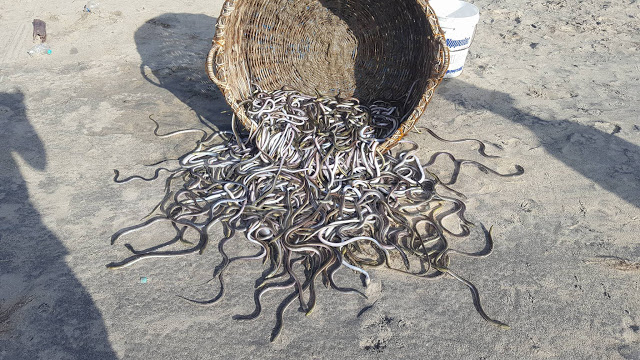By Malaka Rodrigo
Reports that swarms of what were initially mistakenly identified as venomous sea snakes had got caught in fishing nets in the east coast, had many puzzled and others worried with rumours spreading of an impending tsunami. But scientists have categorically said they are not sea snakes but a species of marine eel.
These creatures had got caught in areas including Batticaloa, Kalladi and Nawalady. They were reported as having slender bodies with the largest specimen being about four feet long.
The National Aquatic Resources Research and Development Agency (NARA) has identified the sea creatures as a species of snake eels. NARA’s Marine Biology Division Head Dr. Sisira Haputantri said that snake eels like fish have gills, a dorsal and anal fins, although not clearly visible like in the case of fish. However, they do not have scales and a tail fin but have tapering tails ending in a point. This gives the species the appearance of a snake.
Explaining further Dr. Haputantri said the species is scientifically categorised into genus Callechelys belonging to the family Ophichthidae. The name itself gives the hint of a snake with the term “Ophichthidae” originating from Greek ophis (“serpent”) and ichthys (“fish”). Some snake eels have coloured spots or stripes to mimic the appearance of venomous sea snakes to deter predators. These eels cannot be consumed as food and have no economic value, according to NARA.
Snake eels live mainly in sandy reefs burrowing in sandy or muddy bottoms waiting to catch their prey of crustaceans and small fish.
According to NARA the snake eels caught in the east may have been washed ashore as a result of conditions in the Bay of Bengal.
This is not the first time such an incident had been reported. Riayas Ahmed, a senior lecturer attached to the Eastern University said a similar infestation of eels was reported in 2012 during this same period of the year.
Marine Biologist Arjan Rajasuriya said that some oceanic fish species show spawning aggregations that could lead to them getting caught. However he said more research needed to be done to find out the reason behind this rare phenomenon.

Meanwhile, snake expert Dr.Anslem de Silva said it is easy to identify sea snakes as they have a rudder-like tail useful in swimming as opposed to the pointed tapering tails that eels have. He said 15 species of sea snakes have been recorded from Sri Lanka, all of them highly venomous. This includes the beaked sea snake (Enhydrina schistose) commonly called ‘Walakkadiya’ in Sinhala. It is regarded as one of the most venomous sea snake in the world.
Veteran diver and marine naturalist, Dr.Malik Fernando said divers occasionally encounter sea snakes and they are common in areas like the Gulf of Mannar. “Sea snakes are stunningly beautiful. They swim underwater hunting for their prey in reef crevices – many eat eels. I have seen them off Negombo. They show no fear of divers. And we have to dodge them when they come our way,” Dr.Fernando added.
Dr.Fernando who is also a medical doctor pointed out that snake antivenom available in Sri Lanka is not effective against sea snakes and warned not to meddle with them if one spots them on a beach or while diving.
Courtesy -Sunday Times-






